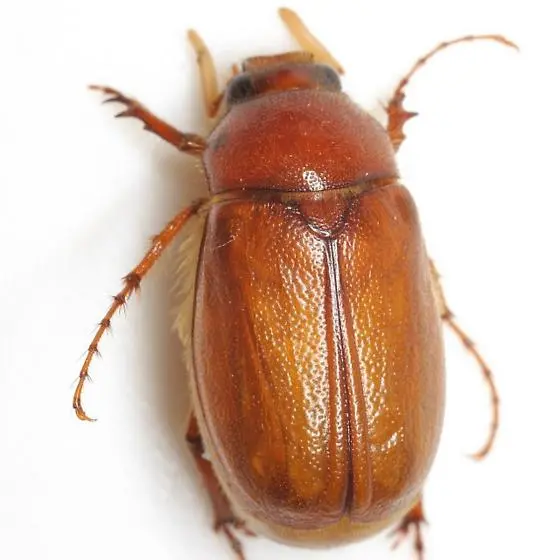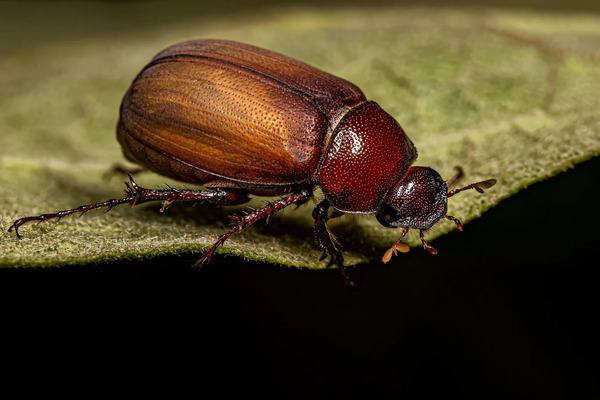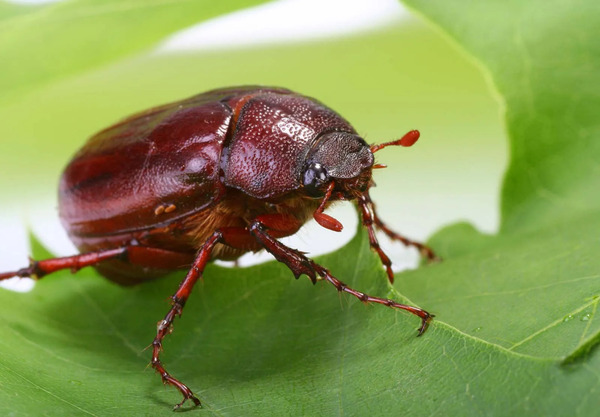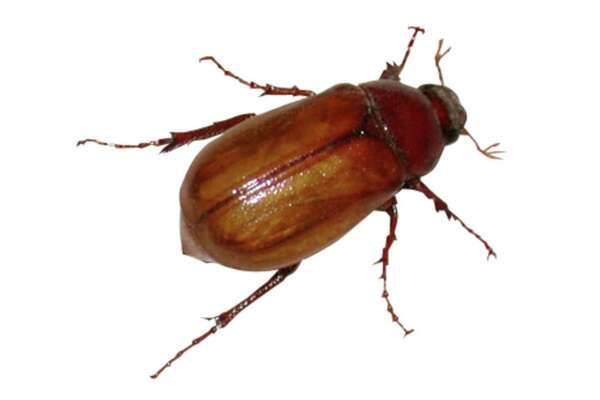The brown June bug, often known simply as the June bug or June beetle, is a type of scarab beetle commonly found in North America, especially during the summer months. This bug’s sudden appearance in early summer, its nocturnal buzzing, and attraction to lights make it easily recognizable. Here, we’ll dive into everything you need to know about brown June bugs, from their appearance and behavior to the role they play in the ecosystem.

The brown June bug (Phyllophaga species) is a member of the scarab beetle family. It’s usually medium to large in size, measuring about 12-25 millimeters (0.5-1 inch) in length. The name “June bug” comes from their seasonal appearance, as they are most commonly seen in late spring to early summer, especially during warm evenings.
Color and Shape: Brown June bugs have a shiny, brown exoskeleton with a slightly rounded, oval shape. The texture of their body can vary from smooth to slightly rough, and they have distinctive antennae with fan-like structures.
Life Cycle: Like other beetles, brown June bugs have four life stages: egg, larva, pupa, and adult. They spend most of their life underground as larvae (often called “white grubs”), feeding on plant roots before emerging as adults.
Brown June bugs are known for their unique nocturnal habits and flying patterns.
Flying and Nocturnal Habits: These beetles are attracted to light, which is why you’ll often see them swarming around porch lights and street lamps. They fly noisily, sometimes bumping into windows and walls, and their buzzing can be heard on warm summer nights.
Where They Live: Brown June bugs are common across North America, particularly in gardens, fields, and grassy areas. They are often found near shrubs, trees, and gardens where their larvae can feed on roots.
The brown June bug’s life cycle plays a key role in its behavior and seasonal appearance:
Egg Stage: Adult females lay eggs in the soil, typically in grassy or garden areas.
Larva (Grub) Stage: After hatching, June bug larvae (known as grubs) feed on plant roots for several months to a couple of years. These white grubs can become pests as they damage lawns and crops.
Pupa Stage: The larvae eventually enter the pupal stage, remaining in the soil while they develop into adults.
Adult Stage: When they emerge from the soil, typically around May or June, they’re in their adult form, ready to mate and continue the cycle.
The adult June bug’s lifespan above ground is short, lasting only a few weeks.
Brown June bugs have different diets depending on their life stage:
Larvae: The grubs primarily feed on the roots of grasses, plants, and crops, making them potentially destructive to lawns, gardens, and agricultural areas.
Adults: Adult brown June bugs generally feed on the foliage of shrubs, trees, and some crops but tend to cause less damage than the larvae.
Brown June bugs are generally harmless to humans but can be a nuisance when they gather around lights in large numbers. While they do not bite or sting, their presence can be startling. However, their larvae can pose a threat to plants and lawns by damaging roots, which may cause yellowing, wilting, or even the death of plants in severe infestations.
Pest Control: If brown June bugs or their larvae are damaging your garden or lawn, there are some natural and chemical control methods available. Beneficial nematodes, insecticides, and natural predators (like birds) can help manage grub populations.
Despite being considered pests by gardeners, brown June bugs play an important role in the ecosystem:
Decomposers: As larvae, they help decompose organic matter in the soil, enriching it.
Food Source: Both adult June bugs and their larvae serve as food for many predators, including birds, small mammals, and reptiles.

“June Bug” Season: While called June bugs, they can emerge as early as May in some regions, continuing through summer.
Light Attraction: June bugs are drawn to lights due to a phenomenon called phototaxis, where certain insects are naturally attracted to light sources.
Lifespan: Although adult June bugs live only a few weeks, their underground larval stage can last several years.
The genus Phyllophaga, commonly referred to as May beetles or June bugs, belongs to the Scarabaeidae family and is one of the largest groups of beetles in North America. There are over 900 species in the Phyllophaga genus, with various species adapted to different habitats and geographic regions. These beetles are notable for their large, robust bodies and distinct feeding habits, which can cause damage to plants, especially during their larval stage. Below is a table detailing a few well-known species of Phyllophaga, including their distinct characteristics, distribution, and any significant environmental impact they may have.
| Species | Common Name | Size | Distribution | Description | Environmental Impact |
|---|---|---|---|---|---|
| Phyllophaga anxia | Common June Beetle | 15-25 mm | North America | Dark brown with a slightly shiny exoskeleton; strong flier | Larvae damage crops, grass, and trees due to root feeding |
| Phyllophaga crinita | Southern Masked Chafer | 12-18 mm | Southeastern U.S. | Yellowish-brown; often has a slightly hairy surface | Major pest of turfgrass; larvae feed on grass roots |
| Phyllophaga implicita | Hairy June Beetle | 10-15 mm | Eastern North America | Light brown to black with fine, hair-like structures covering the body | Causes noticeable damage to lawns; larvae feed on various plant roots |
| Phyllophaga hirticula | Shining Leaf Chafer | 12-22 mm | Eastern U.S., Canada | Glossy dark brown or black with smooth body surface | Larvae feed on roots of grasses and crops, impacting turf and agricultural areas |
| Phyllophaga rugosa | Rugose June Beetle | 18-22 mm | Central and Eastern U.S. | Dark brown, slightly ridged texture; stout body | Root-feeding larvae are a pest to grass and crops |
| Phyllophaga fusca | Fuscous June Beetle | 12-20 mm | Widespread in North America | Brown to black in color; robust body structure | Known to damage lawn and ornamental plants |
| Phyllophaga ephilida | Appalachian June Beetle | 15-22 mm | Appalachian Mountains | Dark brown with a smooth exoskeleton; adapted to mountainous regions | Limited data, but larvae likely impact native vegetation |
| Phyllophaga rubiginosa | Rusty June Beetle | 12-18 mm | Eastern and Southern U.S. | Reddish-brown; smooth body; feeds mainly on roots | Larvae cause moderate to severe damage to turf and plants |
Most Phyllophaga species have larvae that can be considered pests due to their diet of plant roots, particularly grasses and crops. The adult beetles are less destructive but may cause minor damage to foliage. Because of their feeding habits, certain Phyllophaga species are of economic concern, especially in agriculture and horticulture, as they impact lawns, golf courses, and pastures. These beetles play a role in soil health as decomposers but can be disruptive in large populations.

The brown June bug, while sometimes a pest, is an intriguing insect that contributes to the natural world in multiple ways. Whether you’re a homeowner with a lawn or simply curious about insects, understanding these beetles' lifecycle, behavior, and impact can help you appreciate their place in the ecosystem. If you encounter brown June bugs this summer, you now know why they’re buzzing around your porch light!
June bugs, also known as May beetles, are not poisonous to humans. They do not bite or sting and are generally harmless if they come into contact with human skin. While they might look intimidating due to their size and hard exoskeleton, they pose no toxic threat. Some people might feel discomfort if they accidentally ingest one or if one lands on them, but there are no known health risks associated with June bugs to humans.
The green June bug (Cotinis nitida) and the brown June bug (Phyllophaga spp.) belong to different species within the larger family of Scarabaeidae, and they exhibit a few noticeable differences in appearance, habitat, and behavior.
| Feature | Green June Bug (Cotinis nitida) | Brown June Bug (Phyllophaga spp.) |
|---|---|---|
| Color | Metallic green with a coppery or yellow underside | Dark brown, blackish, or reddish brown |
| Size | 1 inch or more, slightly larger | Typically 0.5 to 1 inch |
| Habitat | Found in southern U.S., drawn to ripe fruit and open fields | Widespread across North America, often in lawns and gardens |
| Behavior | Active during the day, known to fly around in daylight hours | Primarily active at night, attracted to artificial lights |
| Diet | Adults feed on fruits, flowers, and plants, especially during late summer | Adults feed on foliage, and larvae feed on plant roots, sometimes causing lawn damage |

June bugs are not aggressive, but their behavior can make it seem like they’re attacking or targeting humans. Here’s why it might feel that way:
Attraction to Light: June bugs, especially the brown variety, are attracted to artificial light sources. If you are standing near an outdoor light or even have a light-colored shirt on, June bugs might mistake you for a light source and fly toward you.
Poor Navigation Skills: June bugs are not known for agile flight. Their large, clumsy bodies can make them awkward fliers, so if they fly in your direction, it’s usually accidental.
Nocturnal Activity: Brown June bugs are mostly nocturnal, meaning they are active at night, which is when people are often sitting outside near lights. Their increased presence around humans in the evening is usually a result of being drawn to lights rather than intentional interaction.
In summary, June bugs are not poisonous, and the differences between green and brown June bugs relate primarily to their color, size, and behavioral habits. When June bugs fly toward you, it’s due to their attraction to light and clumsy flight, not aggression.
animal tags: Brown-June-Bug
We created this article in conjunction with AI technology, then made sure it was fact-checked and edited by a Animals Top editor.